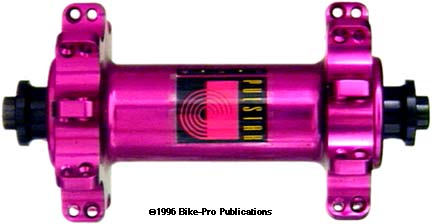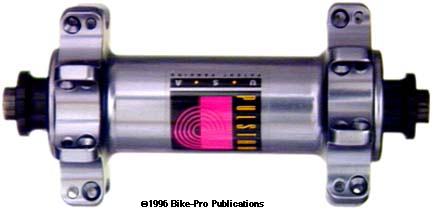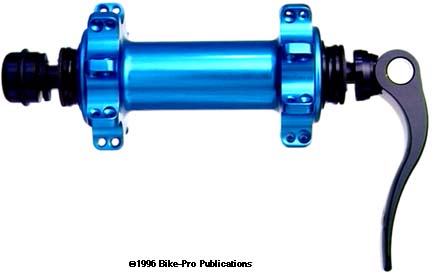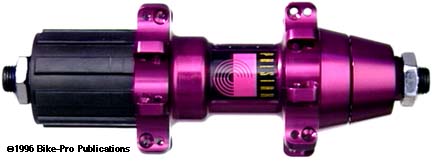
Pulstar makes four models of what are known as straight pull hubs. They are straight pull because these have don't have flanges in the conventional sense. Common flanges require the spoke to pass through the hub perpendicular to the line of bike travel. The spoke must then turn at 90 degrees to reach the rim. This bend at the spoke head to permit the spoke to reach the rim is well known as the spokes chief weakness. As the hub rocks slightly from side to side with each turn or pedal stroke, the hub flange wears away the supporting area around the head leading it to ultimately snap off. Spoke head failure is far less likely to occur with these hubs. At each end of the hub shell there are a certain number of points, (11mm wide) which the spokes anchor in. The number varies with the spoke count, there are seven points on each side carrying two spokes on the 28 hole hub. There are eight points with two holes each at each end of the 32 hole hub. Each hole is countersunk, one in each direction. The spoke passes through in a straight line toward the rim. The spoke in the hole next to it passes in the opposite direction straight to the rim. The spokes behave as through they are radially laced, that is straight to the rim with no crosses, but Pulstar hubs are intended to built with crossed spokes. Naturally using these hubs means that you have to use matching straight pull spokes. There is a couple of sources for Titanium wire straight pull spokes. Please look in our spoke section for more on straight pull spokes. Besides four models of hub, Pulstar makes them in up to six colors with two hole drillings. Look, here's the dilemma, when you try, in the bike industry, to establish a new standard, the only way that it will ever be widely accepted is if you can get the large bike factories in Taiwan, China, (and where ever the industry thinks the next least expensive labor pool is likely) to use your idea on the production bikes ordered by all the big names, Scott USA (only it really isn't as USA as you would think), Schwinn (really Scott USA under another banner), Raleigh, Trek, Specialized, GT, Bianchi, and all the other names used on bikes. In order to get your new standard on bikes made in the orient, you either ship the American made version to them, or more likely, you have a Taiwan maker, for less money, manufacture the parts you want installed on bikes. In this way, they are in-expensive, and locally available for the bike factories. This is a big part of the OnZa and Ritchey success, and Aheadsets really succeeded only once there was Asian production. Now, if you get an Asian factory to build a copy of your part for less money, in volume, even though the quality isn't exactly what you really want, but it appears good enough to get away with (to everyone except the really knowledgeable), how long do think it will take before the American manufacturer starts selling only the Taiwan copy at a higher profit without letting anyone know? More often than you think, in fact, it happens all the time. For Pulstar hubs to really be adopted they will have to be specified on factory built bikes, not just aftermarket replacements. Many times to get around the aura of this "made in the orient to price" perception companies will use "USA" in their name. Keep this in mind as you read through these reviews and consider it more broadly in your reading of bike parts.
After Pulstar trashed its name selling the Taiwan import as "Us Quality" with replacements of the freehub mechanism being unavailable, they tried to introduce a "9000 Series" hub. No one has bought into it and Pulstar is dying the writhing death the self-induced.

The Pulstar standard front hub, is relatively simple in design. The shell is one piece, CNC machined from 6061 T-6 billet aluminum. The hub shell is drilled through and bored from each end to make a seat and recess the bearings. Two NMB 629D precision sealed bearing cartridges, from Singapore, are used for bearings. One bearing is pressed into the hub then an aluminum tube is inserted into the shell. The tube has an inner diameter slightly larger than the axle's outer diameter. The axle is made from Cro-moly steel.

It's thin walled and hollow, with a 9mm outer diameter and a 6.33mm inner diameter. The aluminum tube operates as a sleeve and adds rigidity to the axle, while inside the hub. With the second bearing pressed into the shell's other end, a Cro-moly steel axle is pushed clear through the hub, including the interior aluminum tube. Although the axle is held firmly by the bearings, two locking collars are used to cinch the axle in place. The collars are machined from aluminum and held in place by a steel set screw with a 2mm hex fitting. It is the outer face of the collar that comes in contact with the fork end. The Pulstar standard front has a 53.7mm hub flange diameter, with the flanges spaced 70mm apart. The Pulstar standard front spoke holes have a 47mm center circle diameter. It is available in either a 28 or 32 spoke hole drilling. The hub shell comes anodized in Blue, Grey, Lavender, or Silver. The weight of a 32 hole Pulstar standard front is 159 grams. NO LONGER AVAILABLE

Pulstar makes a Suspension front hub to satisfy the interests of over enthusiastic Mountain bike riders. The Suspension front hub uses an oversized axle within the same CNC machined billet hub shell. The hole drilled through the hub and the bores performed from each end are done in a larger diameter. The bores are 30mm in diameter and the through holes is 22.5mm. To accommodate the larger hole and larger a larger sealed bearing is used, in this case its the Japanese WTW 6903RS. The aluminum tube for this version of the Pulstar front passes all the way through the hub. It has a 17mm outer diameter and a 9.1mm inner diameter. The axle for this hub is machined from 6061-T6 aluminum rod. It has a 9mm outer diameter and slides through the thicker aluminum tube. The description now gets slightly more complicated. The Suspension hub comes with a quick release skewer, only it's incorporated into the axle. The axle has interior threads on one end, and has a permanently fixed "nut" at the other. The axle with the nut passes through from one side of the hub and a short length, (16mm long) steel skewer threads into the axle's inner threads from the other. A lever actuates a cam which constricts the axle/skewer locking the front wheel to the bike. A machined aluminum cap at each end of the axle has a fastened serrated face steel washer. This 22mm diameter steel face is what makes contact with the inner fork end. We found the hub actually revolving on the larger aluminum outer axle, until weight was placed on it, when the revolving bottom of the larger aluminum rather pushed against the bearing making it finally turn. This is because the larger aluminum axle is slightly under sized and revolves freely when bearing no weight. If it were made large enough that it required pressing through the bearings it would use them more effectively. As it is, the aluminum to steel contact is un-lubricated leading to premature eradication of the aluminum axle. Some re-engineering is in order. Changing the outer axle or the end caps would make the difference. The Pulstar Suspension front has a 53.7mm hub flange diameter, with the flanges spaced 70mm apart. The Pulstar standard front spoke holes have a 47mm center circle diameter. It is available in either a 28 or 32 spoke hole drilling. The hub shell comes anodized in Blue, Black, Grey, Lavender, Silver. The inner axle, caps, nut and lever are anodized Black. The weight of a 32 hole Pulstar Suspension front with lever is 232 grams. NO LONGER AVAILABLE

This is where Pulstar correctly sees the rear hub market going. This hub is the combination of American thinking, with some Asian parts. The hub shell is CNC machined of a single piece of billet aluminum, in a highly complex bit of work. The shell is drilled through to reduce weight, and bored on the non-drive side to reduce weight. At the drive side the hole is tapped with 22mm by 1mm thread pitch threads. These threads are for the Taiwan made screw-in freehub mechanism. The freehub is easy to remove using a 10mm hex wrench inserted in the end of the freehub and turned counter-clockwise. Unlike the Shimano 10mm hex bolt which comes out as a separate piece, the whole freehub mechanism is removed with this model. The freehub uses a set of nine 6.35mm diameter steel ball bearings to carry the outer load. A rubber seal at the outside of the freehub reads "KT", "SEALED", "T W N R O C", "17298". This leads us to believe the entire freehub mechanism is made in Taiwan by "KT", unfortunately the freehub isn't sealed in any conventional way that a term like "sealed" would infer, on an aftermarket replacement cassette hub. A low quality steel axle is used, with a matching low quality steel cone race, and inexpensive chrome locknuts. The quality of work on these parts leads us to believe that they arrived with the freehub from the orient. A Korean KBC 6000D precision sealed bearing cartridge is pressed into the non-drive side. The non- drive bearing is covered by a machined aluminum cap held inplace another of the inexpensive chromed locknuts. Our guess is this hub is a good candidate for direct from the orient importation. (we have learned that Pulstar intends to change the chrome lock nuts to Black, look for the KT label on the freehub). As for the cassette to use with this freehub. We tried Shimano's new XT spider type, the CS-M737 and found the spider holding the sprockets together came in direct contact with the hub shell. Though it will revolve, the spider will grind against the shell wearing it away, until you tighten it so it will wear the shell down further, all the while inducing friction and drag. We also tried the Shimano HG-90 and the HG70-8 speed cassette sets, and found about the same results. In this case, there are three rivets which hold the largest 6 cogs together as a unit. These rivets protrude slightly a both ends, and Shimano freehub bodies and everyone elses takes this into account. The Pulstar "KT" freehub however, allows the rivets in contact with the hub shell, scoring it. This grinding was even worse than the M737 cassette. The only way to get an HG-90 or HG-70 to work decently, yet imperfectly, would be to use a grinder to remove the three rivets. The Pulstar Cassette rear has a 53.8mm hub flange diameter, with the flanges spaced 54mm apart. The Cassette rear spoke holes have a 47mm center circle diameter. This hub is available only in a 32 spoke hole drilling only. It comes in a 135mm axle length for 8 speed mountain use. The hub shell is anodized in Blue, Black, Grey, Lavender, or Silver. The weight of a 32 hole Pulstar Cassette rear is 410 grams. To work on the hub you will need a 17mm box wrench to loosen the locknut while using a 15mm cone wrench to hold then loosen the machined aluminum axle cap. The axle has an internal shoulder, striking it from the drive side pushes out the non-drive bearing, a 10mm wrench removes the freehub body. NO LONGER AVAILABLE